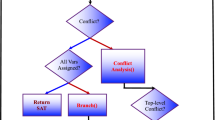Abstract
In this paper, we present a perspective on modern clause-learning SAT solvers that highlights the roles of, and the interactions between, decision making and clause learning in these solvers. We discuss two limitations of these solvers from this perspective and discuss techniques for dealing with them. We show empirically that the proposed techniques significantly improve state-of-the-art solvers.
Similar content being viewed by others
References
Andrews, P.B.: Resolution with merging. J. ACM 15(3), 367–381 (1968)
Audemard, G., Bordeaux, L., Hamadi, Y., Jabbour, S., Sais, L.: A generalized framework for conflict analysis. In: Proceedings of 11th International Conference on Theory and Applications of Satisfiability Testing(SAT), pp. 21–27 (2008)
Bacchus, F., Winter, J.: Effective preprocessing with hyper-resolution and equality reduction. In: Proceedings of International Conference on Principles and Practice of Constraint Programming (CP), pp. 341–355 (2003)
Beame, P., Kautz, H., Sabharwal, A.: Towards understanding and harnessing the potential of clause learning. J. Artif. Intell. Res. 22, 319–351 (2004)
Biere, A.: Picosat essentials. Journal on Satisfiability, Boolean Modeling and Computation (JSAT) 4, 75–97 (2008)
Biere, A., Sinz, C.: Decomposing sat problems into connected components. Journal on Satisfiability, Boolean Modeling and Computation (JSAT) 2 (2006)
Davis, M., Logemann, G., Loveland, D.: A machine program for theorem-proving. Commun. ACM 5(7), 394–397 (1962)
Dershowitz, N., Hanna, Z., Nadel, A.: A clause-based heuristic for sat solvers. In: Proceedings of 8th International Conference on Theory and Applications of Satisfiability Testing(SAT), pp. 46–60 (2005)
Dershowitz, N., Hanna, Z., Nadel, A.: Towards a better understanding of the functionality of a conflict-driven sat solver. In: Proceedings of 10th International Conference on Theory and Applications of Satisfiability Testing(SAT), pp. 287–293 (2007)
Eén, N., Sörensson, N.: An extensible sat-solver. In: Proceedings of 6th International Conference on Theory and Applications of Satisfiability Testing(SAT) (2003)
Eén, N., Biere, A.: Effective preprocessing in sat through variable and clause elimination. In: Proceedings of 8th International Conference on Theory and Applications of Satisfiability Testing(SAT), pp. 61–75. Springer, New York (2005)
Frost, D., Dechter, R.: In search of the best constraint satisfaction search. In: AAAI ’94: Proceedings of the Twelfth National Conference on Artificial Intelligence, vol. 1, pp. 301–306. American Association for Artificial Intelligence, Menlo Park (1994)
Ginsberg, M.L.: Dynamic backtracking. J. Artif. Intell. Res. 1, 25–46 (1993)
Goldberg, E., Novikov, Y.: Verification of proofs of unsatisfiability for CNF formulas. In: Proceedings of Design, Automation and Test in Europe (DATE) (2003)
Hamadi, Y., Jabbour, S., Sais, L.: Manysat: solver description. Tech. Rep. MSR-TR-2008-83, Microsoft Research (2008)
Hertel, P., Bacchus, F., Pitassi, T., Van Gelder, A.: Clause learning can effectively p-simulate general propositional resolution. In: Proceedings of the Twenty-Third AAAI Conference on Artificial Intelligence (AAAI), pp. 283–290 (2008)
Huang, J.: A case for simple sat solvers. In: Proceedings of International Conference on Principles and Practice of Constraint Programming (CP), pp. 839–846 (2007)
Jin, H., Somenzi, F.: Strong conflict analysis for propositional satisfiability. In: DATE ’06: Proceedings of the Conference on Design, Automation and Test in Europe, pp. 818–823. European Design and Automation Association, 3001 Leuven (2006)
Le Berre, D.: Exploiting the real power of unit propagation lookahead. In: Kautz, H., Selman, B. (eds.) Workshop on Theory and Applications of Satisfiability Testing(SAT’01), pp. 59–80. Elsevier Science, Boston University, Massachusetts, June 2001
Li, C.M.: Heuristics based on unit propagation for satisfiability problems. In: Proceedings of 15th International Joint Conference on Artificial Intelligence (IJCAI), pp. 366–371 (1997)
Li, C.M.: A constraint-based approach to narrow search trees for satisfiability. Inf. Process. Lett. 71(2), 75–80 (1999)
Lynce, I., Marques-Silva, Jo a. Probing-based preprocessing techniques for propositional satisfiability. In: ICTAI ’03: Proceedings of the 15th IEEE International Conference on Tools with Artificial Intelligence, p. 105. IEEE Computer Society, Washington, DC (2003)
Marques-Silva, J.P., Sakallah, K.A.: GRASP—a new search algorithm for satisfiability. In: Proceedings of IEEE/ACM International Conference on Computer-Aided Design, pp. 220–227 (1996)
Moskewicz, M., Madigan, C., Zhao, Y., Zhang, L., Malik, S.: Chaff: engineering an efficient sat solver. In: Proceedings of 39th Design Automation Conference (DAC), pp. 530–535 (2001)
Nieuwenhuis, R., Oliveras, A., Tinelli, C.: Solving SAT and SAT modulo theories: from an abstract davis–putnam–logemann–loveland procedure to DPLL(T). J. ACM 53(6), 937–977 (2006)
Pipatsrisawat, K., Darwiche, A.: Rsat 1.03: sat solver description. Tech. Rep. D–152, Automated Reasoning Group, Computer Science Department, UCLA (2006)
Pipatsrisawat, K., Darwiche, A.: A lightweight component caching scheme for satisfiability solvers. In: Proceedings of 10th International Conference on Theory and Applications of Satisfiability Testing(SAT), pp. 294–299 (2007)
Pipatsrisawat, K., Darwiche, A.: Rsat 2.0: sat solver description. Tech. Rep. D–153, Automated Reasoning Group, Comp. Sci. Department, UCLA (2007)
Pipatsrisawat, K., Darwiche, A.: A new clause learning scheme for efficient unsatisfiability proofs. In: Proceedings of the Twenty-Third AAAI Conference on Artificial Intelligence (AAAI), pp. 1481–1484 (2008)
Ryan, L.: Efficient algorithms for clause-learning SAT solvers. Master’s thesis, Simon Fraser University (2004)
Sörensson, N., Eén, N.: Minisat 2.1 and minisat++ 1.0–sat race 2008 editions. SAT-Race 2008 solver descriptions (2008)
Subbarayan, S., Subbarayan, S., Pradhan, D.K.: Niver: non increasing variable elimination resolution for preprocessing sat instances. In: In Proc. 7th International Conference on Theory and Applications of Satisfiability Testing (SAT, pp. 276–291. Springer, New York (2004)
Zhang, L., Madigan, C.F., Moskewicz, M.W., Malik, S.: Efficient conflict driven learning in boolean satisfiability solver. In: Proceedings of International Conference on Computer-Aided Design, pp. 279–285 (2001)
Author information
Authors and Affiliations
Corresponding author
Rights and permissions
About this article
Cite this article
Pipatsrisawat, K., Darwiche, A. On Modern Clause-Learning Satisfiability Solvers. J Autom Reasoning 44, 277–301 (2010). https://doi.org/10.1007/s10817-009-9156-3
Received:
Accepted:
Published:
Issue Date:
DOI: https://doi.org/10.1007/s10817-009-9156-3




